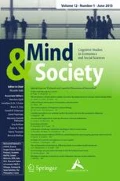Abstract
The aim of this paper is to focus on the specificities of the creative processes in taste industries: industries that have connected the artistic and industrial dimensions to supply goods and services—demand for which derives not from the logic of needs and necessity, but from the logic of pleasures, tastes, ethic preferences and hedonism. These taste industries belong to the creative industries but, unlike scientific and technological production, they work not on the basis of cumulative knowledge (replacing goods by better quality amenities over time) but through the creation of ideas, drawings, recipes, goods and services which pass through time, and which constitute heritages. Thus, creativity works on the basis of heritages: that is, past and accumulated creativity. The paper considers how the different types of heritage (craftsmanship knowledge, creative knowledge, tastes, institutional heritage and common cultural heritage) contribute to creative process. It concludes on the double-edged effect of heritages, which while bestowing competitive advantages and favouring the development of creativity, do orient development along a given path, promoting a certain kind of creativity that may lead to lock-in effects, and build obstacles in the way of development.

Similar content being viewed by others

Notes
Rochefort (2001) reports the increasing consumer demand for heritage, which is construed as a demand for stability. Consumers are anxious to rediscover their traditions, their history; they are looking for their 'roots'. Moreover, in a global world, consumers seek to be world citizens and consumers, to broaden their knowledge and understanding of other people and creations, and, particularly, their gastronomic creations.
We use the word “heritage” in a meaning different from the one generally used. Heritages include not only "official" and "institutional" heritages as museums, libraries, archaeological and historic sites, archives, and so on but also all the heritages made by the accumulation and sedimentation of creativity: for instance the heritage of know-how constituted in the Maison de couture or the recipes characteristic of culinary cultures.
Marilyn Monroe famously told a reporter in 1954 that all she wore in bed was “five drops of Chanel N°5,” thereby creating millions of fantasies among her own admirers and long lines at department store perfume counters in the USA.
Today the majority of goods include a lot of characteristics, among which some taste characteristics. For instance car industry supplies cars with sophisticated design to appeal to consumers’ tastes. Nevertheless, for almost people, cars remain utilitarian goods. Addis and Holbrook (2001) distinguish ‘utilitarian products', ‘hedonic products', and ‘balanced products'. Taste industries refer to hedonic products.
Roux E (2001) La conciliation des contraires: créativité et rigueur dans la gestion de l’identité d’une marque, communication to the workshop La mode, un laboratoire de créativité, Turin, ICER, octobre 2001.
References
Addis M, Holbrook MB (2001) On the conceptual link between mass customisation and experiential consumption: an explosion of subjectivity. J Consumer Behav 1(1):50–66
Barrère C, Chossat V (2004) Intellectual property rights and cultural heritage; the case of non-cumulative and non-degenerative creation. RERCI 1(2):97–117
Caves RE (2000) Creative industries. Harvard University Press, Cambridge, Contracts between Art and Commerce
Cova V, Cova B (2001) Alternatives marketing : réponses marketing aux évolutions récentes des consommateurs. Dunod, Paris
DCMS (2001) UK Government Department for Culture, Media and sport. Annual Report 2001. www.culture.gov.uk/. Accessed 12 June 2012
Elias N (1973) La société de Cour. Flammarion, Paris
Fischler C (1993) L’homnivore. O. Jacob, Paris
Florida R (2002) The rise of the creative class and how it’s transforming work, leisure and everyday life. Basic Books, New York
Graham B, Howard P (eds) (2008) The ashgate research companion to heritage and identity. Ashgate Publishing, Farnham
Harrison R (2012) Heritage: critical approaches. Routledge, London
Hirschman EC, Holbrook MB (1982) Hedonic consumption: emerging concepts, methods and propositions. J Marketing 46(3):92–101
KEA (2006) The economy of culture in Europe. Study prepared for the European commission (Directorate-general for education and culture). www.keanet.eu/ecoculture/studynew.pdf. Accessed 14 June 2012
Klein B (2000) The moral content of tradition. Homecraft, ethnology, and swedish life in the twentieth century. West Folk 59:171–195
Laver J (1995) A concise history of costume. Thames and Hudson, London
Le Breton D (2002) Signes d’identité. Tatouages, piercings et autres marques corporelles. Métailié, Paris
Lehnert G (2000) Histoire de la mode au XX° siècle, édition française. Könemann, Paris
Lipovetsky G (1987) L’empire de l’éphémère. Gallimard, Paris
Lipovetsky G (2006) Le bonheur paradoxal. Gallimard, Paris
Ministère des Affaires étrangères et européennes (2009) Rapport Industries culturelles et Ministère des affaires étrangères et européennes. www.diplomatie.gouv.fr/~/091005. Accessed 14 June 2012
North D (1991) Institutions, Institutional Change and Economic Performance. Cambridge University Press, Cambridge
Rochefort R (2001) La société des consommateurs. Odile Jacob, Paris
Santagata W (2011) The culture factory. Creativity and the production of culture. Springer, Heidelberg
Sen AK (1977) Rational fools: a critique of the behavioral foundations of economic theory. Roy I Phs 6(4):317–344
Throsby D (2001) Economics and culture. Cambridge University Press, Cambridge
Tornqvist G (1983) Creativity and the renewal of regional life. In: A. Buttimer (ed.) Creativity and context: a Seminar Report, 91–112, Lund studies in geography. B. Human geography, N°50 Lund: Gleerup
Towse R (2003) A handbook of cultural economics. Edward Elgar, Cheltenham
Tunbridge JE, Ashworth GJ (1996) Dissonant heritage: the management of the past as a resource in conflict. Wiley, Chichester
Author information
Authors and Affiliations
Corresponding author
Rights and permissions
About this article
Cite this article
Barrère, C. Heritage as a basis for creativity in creative industries: the case of taste industries. Mind Soc 12, 167–176 (2013). https://doi.org/10.1007/s11299-013-0122-8
Received:
Accepted:
Published:
Issue Date:
DOI: https://doi.org/10.1007/s11299-013-0122-8



